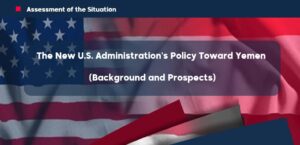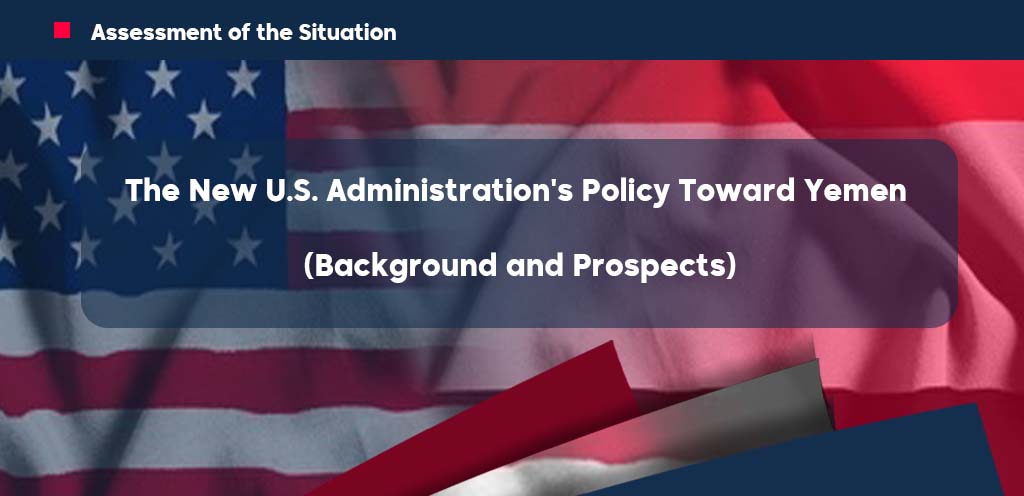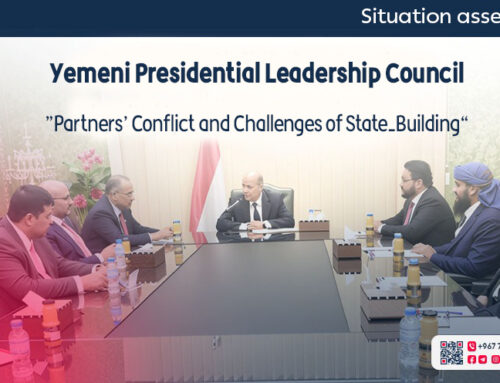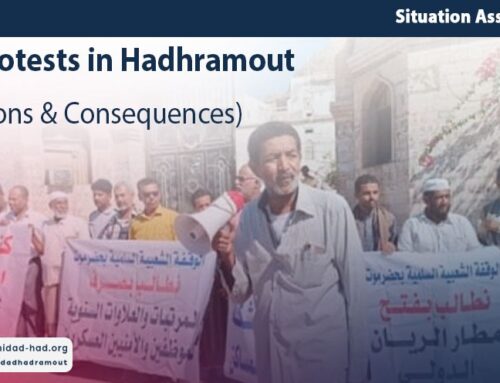Situation Assessment
February 2025
The New U.S. Administration’s Policy Toward Yemen
(Background and Prospects)
Introduction
Yemen’s geopolitical importance is increasing day by day in its regional and international surroundings, especially recently at a rapid pace following the events that have unfolded in the region since the launch of Operation Al-Aqsa Flood and the subsequent significant reactions—both positive and negative. This has brought discussions about the Yemeni situation to the forefront on all tables and within political corridors at international forums recently.
Previously, successive U.S. administrations gave the Yemeni file little importance due to its intersection with other, more critical issues in the region. However, with Donald Trump’s new administration in his second term, which began on January 20, 2025, the Yemeni file will be among the top priorities on the table, particularly in light of new developments in the Red Sea region and the emergence of threats to U.S. interests in an unprecedented manner. Although Trump’s first term in the White House provided insights into his policies on specific issues and his expected approach to complex files such as Yemen, there are indications of potential shifts in his approach during his upcoming tenure compared to his first term.
In this paper, we will examine the potential policies of the new U.S. administration toward Yemen, the intersecting issues surrounding it from various perspectives, and the impact of Trump’s first term in the White House (2017–2020) on his forthcoming policies.
First: Trump’s First-Term Policies Toward Yemen
During his presidency from 2017 to 2020, Trump did not treat the Yemeni file as a primary issue but rather as a secondary matter linked to the files of Gulf allies and the Iranian file. His focus was on America’s strategic interests, most notably counterterrorism, strengthening relations with regional allies—particularly the Kingdom of Saudi Arabia—and the Iran file.
The results of this approach were negative, as it failed to benefit from previous experiences and lessons regarding the Yemeni issue through past administrations. This is because Yemen and its crisis are closely tied to the affairs of Gulf countries and the counterterrorism file. Trump’s administration’s policy toward Yemen from 2017 to 2020 can be summarized as follows:
- Supporting the Arab Coalition and Conducting Military Counterterrorism Operations
One of the key aspects of Trump’s policy toward Yemen was his strong support for the Saudi-Emirati coalition in its military operations alongside the internationally recognized Yemeni government against the Iran-backed Houthi group, which had overthrown former President Abdrabbuh Mansur Hadi. Trump resumed supplying the coalition with weapons and military equipment, in addition to providing intelligence and logistical support.
He went even further in his support for the Arab coalition by using his presidential veto in April 2019 to overturn a congressional resolution aimed at ending U.S. support for the coalition’s war in Yemen[1]. The United States also intensified military and intelligence pressure against these groups and ordered direct military operations targeting Al-Qaeda figures using drone strikes. These operations led to the killing of key Al-Qaeda leaders, most notably Qasim al-Raymi, the leader of “Al-Qaeda in the Arabian Peninsula,” who was targeted in an airstrike on a house where he was hiding in eastern Marib in late January 2020[2].
- Financial Sanctions on Entities and Individuals
Trump focused on combating the financing of terrorist groups, imposing numerous sanctions on entities and individuals accused of supporting and funding terrorist activities, particularly the Houthi group, as a means of exerting strong pressure on Iran. One of his most notable decisions before leaving office was designating the Houthis as a terrorist organization[3] and banning financial transactions with the group. This move was strongly supported by Saudi Arabia, the UAE, and the internationally recognized Yemeni government.
However, Biden later revoked this designation, only to reinstate it in early January 2024[4] after the Houthis began attacking commercial ships in the Red Sea, posing a threat to the vital shipping route passing through the area.
- Political Diplomacy and the Humanitarian Aspect
Despite military support for the coalition, the Trump administration made some diplomatic efforts to end the conflict. At times, it resorted to diplomacy to support the United Nations and its special envoy to Yemen, publicly advocating for a return to negotiations. It also pressured its Gulf allies and the Yemeni government to halt the battle to liberate the city of Hodeidah from the Houthis, leading to the Stockholm Agreement[5] in December 2018, brokered by the UN. This agreement stopped the military operation against Hodeidah, but its provisions were not fully implemented.
In late 2019 and early 2020, attempts were made to stop the fighting between warring parties, with some progress in peace talks, but no significant breakthrough was achieved. While the Trump administration officially supported humanitarian efforts—citing them as justification for the Stockholm Agreement—it simultaneously cut U.S. humanitarian aid to Yemen in March 2020[6]. This funding suspension worsened the humanitarian crisis in the country.
- Confronting Iranian Influence
The Trump administration viewed the war in Yemen as part of Iran’s regional influence, believing that Iran needed to be defeated in this conflict to curb its expansion. The administration considered Iran’s support for the Houthis a threat to U.S. national security and worked aggressively to pressure Iran. This included imposing sanctions on Iran’s ambassador to Sanaa at the time, Hassan Irloo[7], as part of broader efforts to prevent Iran from providing support to the Houthis in Yemen.
Second: Biden’s Policies Toward Yemen
Biden’s policy toward Yemen has undergone significant changes, which have had a considerable impact on both Yemen and the broader region. Since taking office, his administration declared that ending the war in Yemen was one of its foreign policy priorities. It also aimed to halt U.S. support for the Saudi-led Arab coalition fighting to restore Yemen’s legitimacy and withdrew air defense systems from Saudi Arabia when it was under attack by the Houthis. Biden appointed Timothy Lenderking as a special envoy, who had extensive experience in the region, to lead diplomatic efforts for a peaceful resolution to the Yemen crisis.
Lenderking made several visits between February 2021 and March 2022, and these efforts led to a significant breakthrough: a two-month ceasefire agreement[8] announced in April 2022. This ceasefire included the suspension of all offensive military operations within Yemen and across its borders, including attacks on Saudi Arabia. It was extended multiple times, eventually becoming a lasting reality, marking the longest ceasefire since the crisis began. This ceasefire was part of a competitive diplomatic effort between the U.S. and the UN special envoys to Yemen. Following this, the announcement of the Presidential Leadership Council was made as a restructuring of the legitimate government to unify its leadership against the Houthis. Some viewed it as a step to push for peace talks between only two parties, after the legitimate government struggled with multiple factions. The Houthis rejected this move, considering the council to be a body established by regional powers (Saudi Arabia and the UAE) and controlled by them, suffering from sharp divisions among its members.
Despite Biden and his administration using different strategies to deal with the Yemen file, they collided with the complexities of the situation in Yemen, the sharp division among internal conflict parties, and the disagreements between the legitimacy’s allies—Saudi Arabia and the UAE. The Biden administration was unable to contain the divisions and disagreements, which weakened the position of the legitimate government and gave the Houthis the strength to escalate their attacks, especially after the Houthi group was removed from the terrorism lists. This escalated the group’s attacks on areas under the control of the legitimate government, and the Houthi attacks evolved to reach vital installations in Saudi Arabia and the UAE, indicating a disregard for the situation and calculations in Yemen and a failure to properly understand the dynamics and roots of the conflict in Yemen.
The attempts to move toward political solutions and negotiations, which were often seen as being between the Houthis as one party and Saudi Arabia as the second party—while ignoring the Yemeni legitimate government in most rounds—continued to try to contain the threat of the Houthi group and the impact of their attacks on the national security of Saudi Arabia and the UAE. Public steps were taken, including the visit of Saudi Ambassador Mohammed Al-Jaber to Sana’a in April 2023, and the statement by Saudi Foreign Minister Prince Faisal bin Farhan that the time had come to implement the peace roadmap in Yemen in July 2024[9], and a round of consultations on the issue of detainees, abductees, and the forcibly disappeared[10] in late June 2024, hosted by the Omani capital, Muscat. However, the Houthi group raised the ceiling of its demands, as it usually does every time, in an attempt to evade the obligations of any agreement it is part of. What encourages this is the lack of pressure from sponsors in all those previous agreements, other than the United States or the United Nations. Thus, all efforts to resolve the Yemeni conflict remained stagnant until the “Flood of Al-Aqsa” operation was launched by the Palestinian resistance (Hamas) in Gaza on October 7, 2023. The Houthi group then declared its military operations in the Red Sea, and these operations later developed to reach the Mediterranean Sea with numerous strikes against the Zionist occupation. This led the Biden administration to change its approach to dealing with the Yemeni file, especially with the Houthi group, which it considered a threat to its interests in the region. The U.S. called for the formation of a military alliance[11]to protect navigation in the Red Sea, deter the Houthis, and initially counter their attacks. The operations then evolved to target Houthi sites in the group’s areas of control in an attempt to weaken the military capabilities of the Houthis. The goal was not to destroy the military capabilities or eliminate the Houthis, as observed from the results of the military strikes directed at them each time, and the targets of these strikes, most of which were civilian sites.
Yemen has witnessed a complex conflict, involving both internal and external factors, with regional and international powers playing a significant role in shaping its course. The shifts in U.S. policy between the Trump and Biden administrations led to major changes in this scene. After Trump’s return to the presidency for a second term, he will face new challenges that differ completely from those during his first term. Trump will have to deal with the rise of the Houthis as a regional power after their previous isolation, and their growing influence on security in the Red Sea, maritime shipping lanes, and the region as a whole. He will also have to determine his position on the Saudi-Iranian rapprochement and how to handle it within the context of his strategy toward the region. The prospects for achieving peace in Yemen will be complicated, given the continued regional tensions and the growing influence of the Houthis. All these challenges require clear strategies to deal with the changing Yemeni and regional situation.
Third: Expected Policies of Trump in His Second Term Toward Yemen
Early discussions have started about the challenges Trump will face during his second term in the White House, following the accumulated chaos from his first term, and Biden’s shaky policies in dealing with the Yemeni file and the complex regional issues that intertwine with it. The conversation has gone further to outline scenarios regarding how Trump and his administration will handle these challenges, and the approaches they will take toward the Yemeni issue. We can establish potential scenarios by analyzing the initial actions and steps taken by Trump and his administration since January 20, 2025:
- Stabilizing the Current Situation and Maintaining the Ceasefire:
One possible scenario is the effort to maintain the ceasefire that began in April 2022 between the internal and external conflicting parties, as declared by the United Nations Special Envoy for Yemen. This would include attempting to implement certain commitments related to the economic side, in order to improve the worsening living conditions that impact all Yemeni citizens, whether in government-controlled areas or Houthi-controlled areas. Supporting this scenario is Saudi Arabia’s desire— as the key regional player in the Yemeni crisis and America’s main ally in the Middle East— to ease tensions and avoid a return to military operations. Saudi Arabia’s continuous efforts to meet with the Houthis in Sana’a through Ambassador Mohammed Al Jaber, as mentioned earlier in this paper, and discussions about a peace roadmap that is said to be ready for signing, especially the first phase (the Confidence-Building Phase), which focuses on stopping the fighting, humanitarian intervention, and addressing the humanitarian issues, indicate a reluctance to make drastic changes in the internal Yemeni landscape. Additionally, Saudi Arabia’s support for the legitimate government through the Saudi program for Yemen’s reconstruction and the King Salman Humanitarian Aid and Relief Center, which has been involved in many projects and in the difficult periods faced by the legitimate government, further supports this scenario. Another step taken by Saudi Arabia in this context is its refusal to join the so-called “Prosperity Guard Coalition” and its rapprochement with the Iranian side under Chinese sponsorship in March 2023[12], to resume relations between Saudi Arabia and Iran— Iran being the main supporter of the Houthi group and the primary influence on the group’s policies, even if it occasionally appears to have limited impact on them, as suggested by some officials in the Islamic Republic of Iran. The concerns of the United States and its European allies about the possibility of a political or military faction with different backgrounds controlling the Yemeni scene in the event of a Houthi collapse in northern regions, similar to what happened in Syria recently, without guarantees to protect American and allied interests in Yemen, is an important factor in attempting to maintain the current situation.
- Supporting Peace Efforts to Resolve the Crisis and End the Conflict:
As mentioned earlier, during his first term in the White House, Trump made diplomatic efforts to halt the conflict between the warring parties, return to the negotiation track, and apply pressure on his Gulf allies and the Yemeni government to reach a political solution to end the Yemeni crisis, particularly during the government’s operation to liberate Hodeidah from the Houthi group. This resulted in a ceasefire and the signing of the Stockholm Agreement in 2018 with the cooperation of the UN Special Envoy to Yemen, as well as talks to end the fighting in late 2019. From this, it appears there is a likelihood of this scenario, especially given the increased discussion about a peace roadmap before the launch of Operation Al-Aqsa Deluge in October 2023, and the understanding on many important points between the key parties—the Kingdom of Saudi Arabia, the sponsor of this roadmap, and the Houthis. Trump’s repeated statements in his electoral speeches that he seeks to end global conflicts during his second term also support this scenario. His administration’s success in reaching a ceasefire agreement between Palestinian resistance groups and the Israeli occupying entity before his inauguration on January 20 is another indicator. Additionally, his frequent remarks during his election campaign[13] about having plans to stop the fighting between Russia and Ukraine, as well as in the Middle East, suggest that the new administration under Trump may pursue similar actions in its approach to the Yemeni crisis. Furthermore, the position of the Houthi group, which is considered one of Iran’s key proxies in the region, may take into account the severe blows suffered by the axis of resistance in recent years, such as Hezbollah in Lebanon, the fall of Bashar al-Assad’s regime in Syria, and direct strikes against Iran— the leader of the project— all of which could prompt the Houthis to preserve their gains from the past period.
- Launching a Military Operation and Settling the Battle with the Houthi Group:
The likelihood of this scenario increases each day as the security situation in the Red Sea and maritime shipping lanes has become more fragile, signaling the end of what is called the peace roadmap. This scenario was one of the most prominent features of Trump’s policy during his first term. Trump was a strong supporter of the Arab coalition in its operations against the Houthi group during Operation Decisive Storm, launched by the Kingdom of Saudi Arabia in 2015[14]. He facilitated the opening of logistics supply lines to provide the coalition with weapons and military equipment in major arms deals, as well as intelligence sharing, ultimately leading to direct and intensive airstrikes by the U.S. Air Force targeting multiple leaders and sites of terrorist groups, according to the U.S. military command and administration.
What strengthens this scenario is Trump’s designation of the Houthi group as a foreign terrorist organization on January 23, after completing his inauguration as president for a second term [15]. The executive order stated in Article 2, “The policy of the United States is to cooperate with its regional partners to eliminate the capabilities and operations of Ansar Allah and deprive it of resources, thus ending its attacks on U.S. individuals and civilians, U.S. partners, and maritime shipping in the Red Sea.” This is particularly true given the concerns of the Gulf states about the return of Houthi strikes on their interests and vital facilities within their territories and the erosion of their trust in American protection. Hence, military operations may be an option at various levels.
- Launching a Targeted and Short Military Campaign against the Houthis:
A limited and precise military campaign to weaken the Houthi military capabilities, preventing them from resuming attacks on international shipping lanes, and targeting some of the high-ranking Houthi military leaders, while not completely eliminating them. The goal would be to maintain the Houthi group as a balance of power with other factions in Yemen’s internal conflict and use political leverage to pressure the leadership of the Saudi-led coalition to restore legitimacy, aiming to end the Houthi coup. Additionally, the security agreements could be tied to normalization with Israel, especially since the United Arab Emirates had already announced its normalization with Israel, being the second party in the Arab coalition. - Leading an Alliance with European and Middle Eastern Allies (Red Sea Coastal Countries):
Initiating a military operation with aerial and naval strikes to eliminate Houthi leadership, target weapons and ammunition storage sites, drone and missile launching platforms, and general military facilities to force the Houthis to retreat from their recent adventures and ambitions of becoming an uncontrollable regional power in the future. - Lifting Restrictions and Reducing Pressure on the Arab Coalition, the Yemeni Government, and Anti-Houthi Factions:
This would involve providing political cover for a wide-ranging military operation (military resolution) to end the Houthi coup and complete the process started in 2015 to restore the state and its institutions from the Houthis. First, this requires building understandings between the leadership of the Arab coalition — Saudi Arabia and the UAE — both of whom fiercely compete for influence within the legitimate government and to undermine each other. This rivalry would affect the functioning of the Presidential Leadership Council formed under their supervision. Political unity and the announcement of policies and regulations governing the PLC’s work would be essential. The return of council members to Yemen’s territory and forcing the various factions that formed the council to agree on unifying forces under the Yemeni Ministry of Defense, subject to its leadership and General Staff, would be necessary for success.
1The War in Yemen: Trump Uses Presidential Veto to Overturn Congress’s Decision to End U.S. Support, BBC NEWS – Arabic
[2] Al-Zahiri’s Heir is Killed… Trump Confirms the Death of Qassem al-Rimi
[3] Pompeo Designates Houthi Rebels in Yemen as a Terrorist Group | PBS News
[4] Biden Administration Re-designates the Houthis as a “Specially Designated Global Terrorist Entity” – What Does This Mean and What Is the Goal? CNN
[5] Full Text of the Stockholm Agreement | OSESGY
[6] The U.S. Congress Pushes Trump to Resume Humanitarian Aid to Yemen
[7] Government Welcomes the U.S. Announcement of Sanctions on “Erlou” | Aden News
[8] A United Nations Initiative for a Two-Month Ceasefire | OSESGY
[9] Riyadh: A Roadmap for Resolving the Yemeni Crisis Is Ready to Be Signed
[10] The Presidential Leadership Council Holds an Extraordinary Meeting to Discuss National Developments
[11] “Prosperity Guard” Alliance – An International Naval Force to Confront the Houthis | Encyclopedia | Al Jazeera Net
[12] Joint Statement at the End of Talks Between the Foreign Ministers of Saudi Arabia and the Islamic Republic of Iran in Beijing
[13] https://x.com/realDonaldTrump/status/1851658527187550629
[14] Launch of the Gulf “Operation Decisive Storm” to Save Yemen
[15] Designating Ansar Allah as a Foreign Terrorist Organization – U.S. Embassy in Yemen
To download click here

The New U.S. Administration’s Policy Toward Yemen (Background and Prospects)




